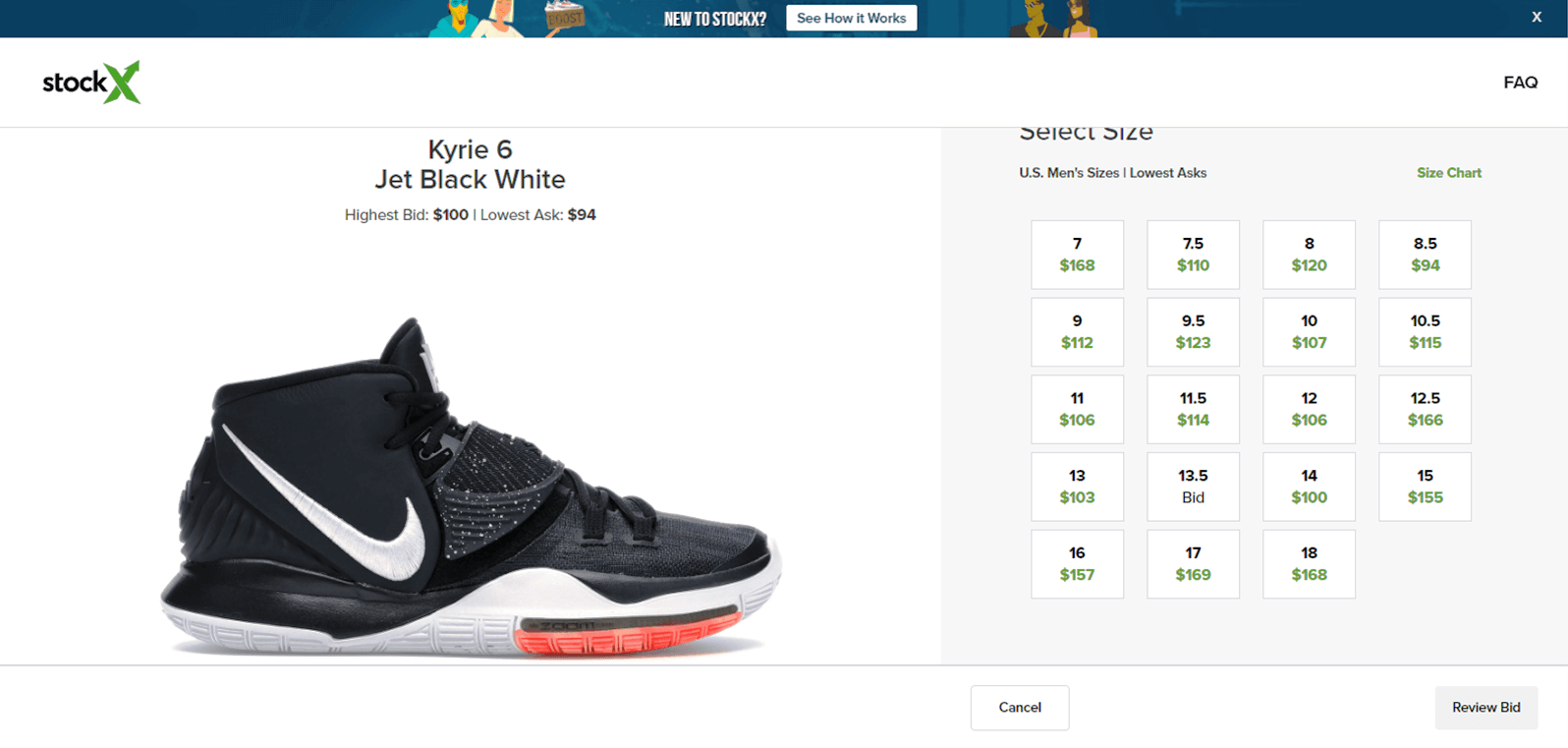![]()
The Kyrie 6 officially launched on 11/22/2019. The shoe was discussed on blogs and sneaker sites as a modernized version of the Air Yeezy 2. The feedback was solid and interaction on social media showed a lot of promise.
Launch Day has arrived and after 3 days (a short release window) for the basic Black/White Kyrie 6 colorway, Footlocker and Hibbett Sports don’t have a single broken size. Jimmy Jazz has a couple of broken sizes, but the third party site StockX already shows a data set that should be disheartening to traditional retail and ecommerce.

The obvious process of analysis should be that it’s far too soon to expect broken sizes a week prior to Black Friday. The doorbuster deals and the hyped sneaker releases that will arrive the closer we move towards “holiday” shopping create the unfortunate problem of “holding” for customers in the market.
The mentions and excitement for this model was considerable and with the way social media and mentions are being regarded in marketing, the Kyrie at 130.00 should have seen some sell through and broken sizes, but that isn’t the case. What is the case is that StockX is showing 94 shoes sold at 22.3% below the retail price and an average sale price of $123.00. For this to take place there are only two things that can be happening:
- Retail outlets are selling their inventory on StockX
- Sellers with discounts are selling their inventory on StockX
In either case StockX has unintentionally set the price of the Kyrie at below retail and this shapes retail as the site garners as much traffic as both Hibbett/City Gear and Jimmy Jazz combined; and more than Footlocker as direct competition.
Website: Traffic
StockX: 15.79 Million/month
Hibbett/City Gear: 3.80 Million/month
Footlocker: 10.87 Million/month
Jimmy Jazz: 2.47 Million/month
I recently wrote a post explaining that resale is dead at retail. Which should mean that StockX shouldn’t have any sales. However the site is both an indicator of how poorly the Kyrie 6 is performing out of the gates in general release and an indicator of where the market wants the Kyrie 6 to be priced.
This leads to a discussion on StockX vs traditional retail. The Suggested Retail Price is really the price wholesale accounts have to sell the shoe for before they can mark it down. Nike does not allow retailers to sell shoes at a discount within the first few weeks of release. Since retailers are ‘stuck’ at 130.00, they are faced with the reality that this model has a baseline set below retail via StockX. The consumer does not have any motivation to pay 130.00 for the shoe if by evidence of StockX’s last five sales, the price is dropping considerably per pair:
| Size | Sale Price | Date | Time |
|---|---|---|---|
| 8 | $101 | Sunday, November 24, 2019 | 11:25 PM EST |
| 10.5 | $95 | Sunday, November 24, 2019 | 6:07 PM EST |
| 10 | $101 | Sunday, November 24, 2019 | 12:44 PM EST |
| 10 | $109 | Sunday, November 24, 2019 | 11:24 AM EST |
| 8 | $101 | Sunday, November 24, 2019 | 10:13 AM EST |
The average price of the last 5 sales is 101.40
The value is trending down. I do understand that every customer isn’t shopping on StockX and that speed of delivery is an issue when a customer purchases on StockX, but traditional retail is in the awkward position in the first week of release of having to answer questions about price matching in-store because of prices online.

StockX holds an unfair advantage that actually contributes to the devaluation of footwear and this hurts all parties involved. Which leads me to the ask the question:
Should StockX implement an SRP first week policy of retail offers only for sellers?
This removes the open marketplace concept, but the sell off that takes place in the stock market is often meant as a correction in most instances. When a general release model is in ‘sell off’ mode in the first week of release, it creates an issue with the backlog of inventory at retail and contributes to inflated prices on more coveted commodities. StockX doesn’t hold any responsibility in making this adjustment. The company earns if the shoe sells for 1 dollar or 1000, but when a general release consistently fails to generate resale from retail, StockX is in danger of cannibalizing itself, or am I wrong?

